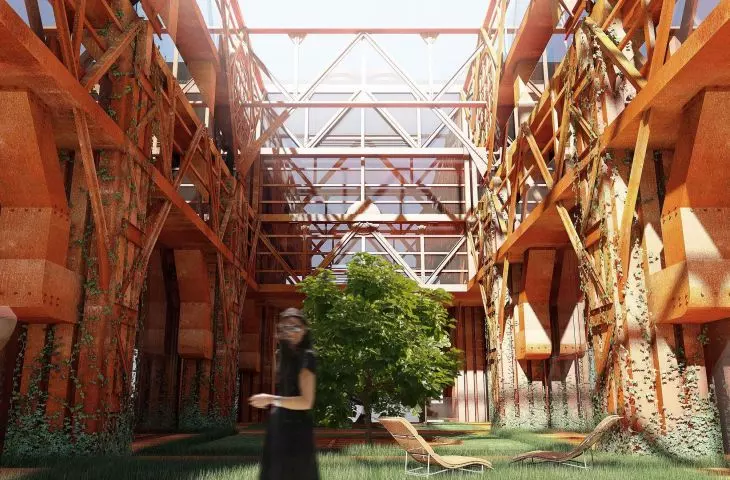Lodz architecture draws handfuls from the city's industrial heritage. Of greatest interest to authorities, investors and designers are post-factory complexes, whose revitalizations are exemplary examples of spaces restored to residents and adapted to serve modern functions. However, completely new buildings are also being constructed in Lodz, which refer to the industrial history of the city - one of them is to be an extravagant in form tenement, designed by Marciniak & Witasiak Architekci.
At Jana Kilińskiego Street in Lodz, a few hundred meters from Liberty Square, Rifleman Park or the University of Lodz building, on an undeveloped plot of land, an unusual tenement house with an extended outbuilding will be built. In the midst of the 19th-century buildings typical of Lodz will grow a building whose forms are closer to the scenery of a steampunk film than to contemporary architecture.
Słoneczne Tarasy in Lodz
© REVISIT HOME | ARCHITEKCI MARCINIAK & WITASIAK | BAM ARCHITECTURE
słoneczne apartamenty
"Słoneczne Apartamenty" will feature 100 apartments described by the developer as premium class units. The offer will include apartments with adjoining gardens or a roof space set aside for them, additionally there will be an underground garage, common areas in the form of an inner courtyard and spaces between individual segments of outbuildings. The building will also include commercial premises.
Słoneczne Tarasy in Lodz
© REVISIT HOME | ARCHITEKCI MARCINIAK & WITASIAK | BAM ARCHITECTURE
a townhouse for the 21st century
The unusual outline of the plot, resembling the shape of the letter "T", became the reason for an attempt to redefine the traditional tenement house layout. The authors of the project started from modern housing standards, which 19th-century buildings are not always able to meet - providing enough light for apartments, accessibility for cars and integration of greenery with architecture.
Słoneczne Tarasy in Lodz
© REVISIT HOME | ARCHITEKCI MARCINIAK & WITASIAK | BAM ARCHITECTURE
The answer turned out to be an atypical spatial shaping of the designed building - behind the openwork facade was a cuboidal body of the building developed around an inner courtyard. The outbuilding behind it took the form of two pairs of wings, located parallel to the course of Jana Kilińskiego Street. This layout helped arrange two inner courtyards with gardens for residents. The vertical structure of the building is also unusual - the successive floors of one of the wings were shaped in the form of terraces receding with height. This allowed the architects to increase the amount of light reaching the interiors.
Słoneczne Tarasy in Lodz
© REVISIT HOME | ARCHITEKCI MARCINIAK & WITASIAK | BAM ARCHITECTURE
Hanging gardens on Kilinskiego Street
The investor and the authors of the project also write a lot about vegetation. The vegetation will be located on the green roofs available to residents, terraces set back from the foundation line and in the alleys to be created between the wings of the outbuildings. However, it is in vain to look for precise information on the pro-ecological solutions used in the building in the presented materials.
Słoneczne Tarasy in Lodz
© REVISIT HOME | ARCHITEKCI MARCINIAK & WITASIAK | BAM ARCHITEKTURA
steampunk in Lodz
The most striking element of the new building on Kilińskiego Street in Lodz will be its front elevation. Its unusual form is the result of an attempt to reconcile two seemingly mutually exclusive requirements - the creation of a front entrance area with a car entrance and the adaptation of the facade's location to the existing building line, which is located right next to the roadway. The solution turned out to be the design of an openwork structure obscuring the actual glass façade of the building with a portico leading directly to the inner courtyard.
Historic interiors of Łódź factories - Inspiration
© REVISIT HOME | ARCHITEKCI MARCINIAK & WITASIAK | BAM ARCHITECTURE
In their design, the architects referred to the economic heritage of Lodz, taking inspiration from industrial production equipment, silos or the structure of scaffolding used during the erection of Lodz factories. The result was an openwork façade made of steel slats, I-beams and other structural elements, painted a rust-orange color. Associations with steampunk aesthetics are right on target here. The facades of the inner courtyard are to look similar - there, between successive spans of scaffolding, round forms will be incorporated, referring to factory flywheels.
Sunny Terraces in Lodz - Concept sketch
© REVISIT HOME | ARCHITEKCI MARCINIAK & WITASIAK | BAM ARCHITECTURE
post-industrial experiment
Designed by Dariusz Witasiak and Paweł Marciniak, the architecture is a bold attempt to face the archetype of the bourgeois tenement house and the post-industrial heritage of Lodz. The project, which has the character of a study experiment, has been directed to implementation, which is now in a fairly advanced stage. What is surprising is the favor of the preservation office, which applauded the unusual approach to the continuation of the building line in the form of an openwork facade - it is not always that preservationists decide to issue permits for such unusual projects. Much more conservative concepts are often met with refusal, as exemplified by the tenement building project, which is to stand on the site of Wroclaw's Solpol, which has been sent for modification. Will the intriguing investment on Kilińskiego Street in Lodz really fit in with the surrounding buildings and the post-industrial character of the city, as the architects would like?

























































